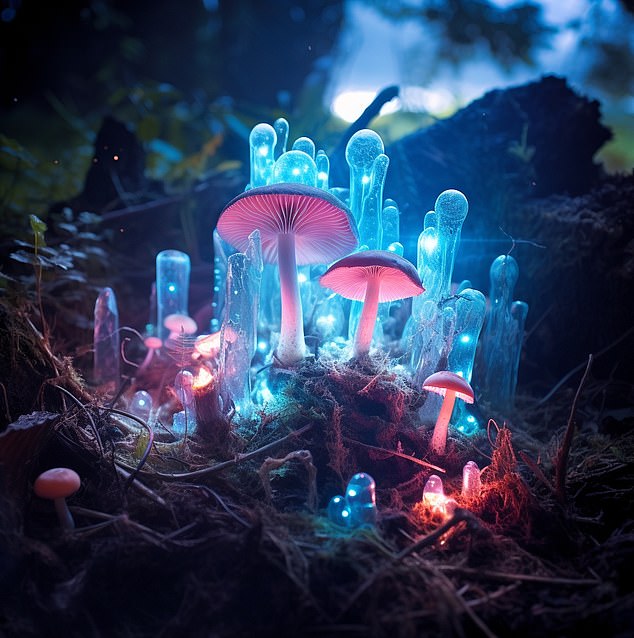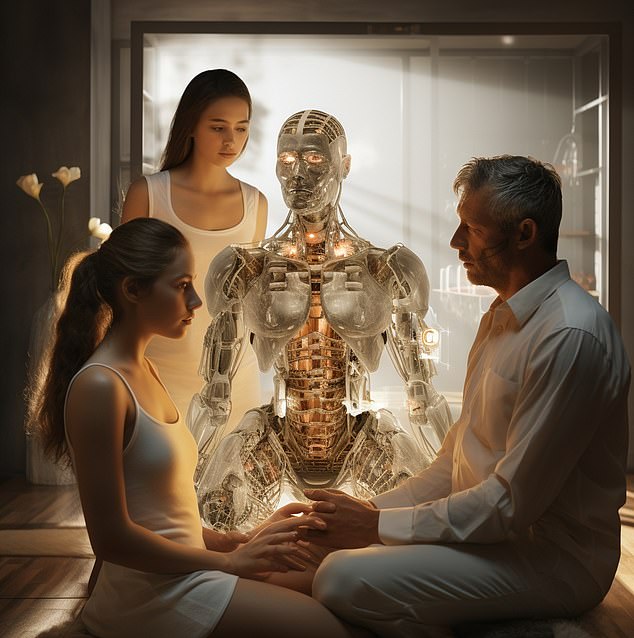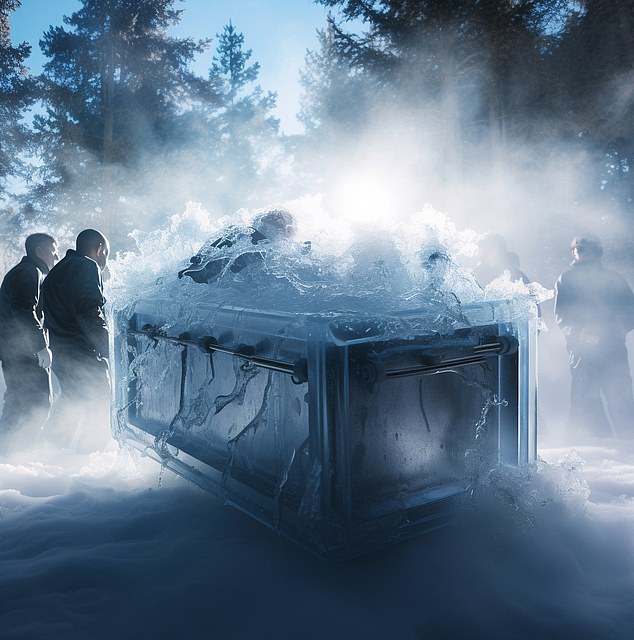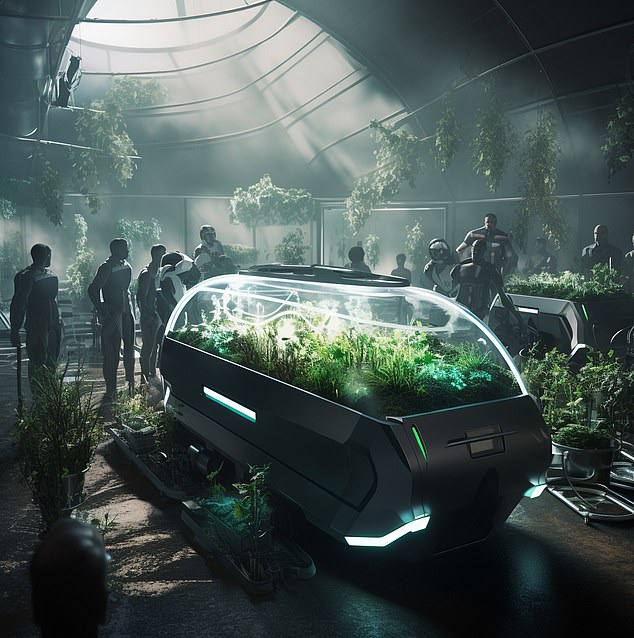Futurists Predict: A Glimpse into Funerals and the Afterlife of 2050—’Digital Twins’ Preserving Life Beyond Death and Loved Ones Downloaded onto Computers
From being buried above ground in a ‘mushroom suit’ to downloading loved ones onto a computer, burial is about to change forever.
Technologies such as artificial intelligence and even genetic engineering will change funerals and death rituals forever, experts tell DailyMail.com.
Even the wake is about to change – with virtual reality versions around the corner, and memorials could take the form of glowing fungi linked to the deceased’s DNA.
Other technologies indicate that death may not be the end, with people hoping to return after their burial.
Talk to your relatives beyond the grave
Can dead people talk to us at their own funerals (Photo Rob Waugh/Midjourney)
In the future, AI technology may allow relatives to talk to their deceased relatives, says Luke Budka, AI strategist at Definition.
For example, it could mean that a deceased person can give a speech at his own funeral.
‘We can already imitate the ‘tone of voice’ of the deceased, as long as there is enough online content to use as a filter.
‘We overlay it on top of a large language model like ChatGPT and presto, you’re having a conversation with someone from the past, like Winston Churchill.
“Companies are now talking to us about combining the ‘voices’ of figures from history to make their CEOs sound particularly optimistic (or conciliatory, for that matter) depending on their current situation.”
Living memorials with the DNA of the deceased

Living memorials linked to the deceased’s DNA could become commonplace (Photo Rob Waugh/Midjourney)
In the future, the memorials of the future could be living things, such as trees or even luminous mushrooms, spliced with fragments of the deceased’s DNA.
The idea of ’transgenic gravestones’, with trees carrying ‘junk DNA’ of the deceased, is not new, but a 2004 project found the procedure to be expensive and complex.
But it could become a reality in the future, says lawyer and technology expert Tautvydas Sutkus, who works for Glow Bar London.
Sutkus said, “Using biotechnology, memorials of the future can be living beings.
‘Imagine a genetically modified tree growing and changing in response to visitors, or bioluminescent organisms lighting up a grave, their brightness and color directly influenced by the deceased’s DNA.’
Virtual reality is waking up

Will virtual reality wakes become common (Photo Rob Waugh/Midjourney)
The pandemic has led to a shift in the way people attend vigils, with some attendees appearing via video link, according to Matthew Lymn Rose.
Rose said: ‘There has been a shift in people’s mindset, they no longer find it as valuable to attend in person, and the pressure to attend has also been lifted.
‘Now we live in a world where people communicate differently. As technologies like livestreaming and virtual reality continue to evolve, people may no longer feel the need to be there in person.”
‘Digital twins’ will live on after death

Digital twins of relatives can live on (Photo Rob Waugh/Midjourney)
After death, people can ‘live on’ in the form of a virtual ‘digital twin’ that can give relatives advice based on their real lives.
Services like Hereafter.AI are already trying to do this to a limited extent, but in the future, advanced AI tools will allow people to ‘live on’ in the form of a virtual replica.
Dr. Ajaz Ali, Head of Business and Computing at the University of Ravensbourne, said: ‘By using language-based tools that will be much more advanced than ChatGPT and Bard, people will be able to interact with these digital twins in real time and benefit from their knowledge and skills. ideas.
“Loved ones can continue to interact with their family members who have already passed away.”
People will be frozen and not buried

Will people be frozen instead of buried? (Photo Rob Waugh/Midjourney)
By 2050, the prospect of coming back to life after death will be more realistic, and more people will choose to be frozen after death.
Currently, Alcor Cryonics offers the service, but it is very expensive, as technology billionaire Peter Thiel, along with Google pioneer Ray Kurzweil, have chosen to preserve his body in liquid nitrogen.
Proponents hope that once they are ‘unfrozen’, medical science will be advanced enough to treat them – otherwise they can be brought back to life in a robot body.
Lawyer and technology expert Tautvydas Sutkus said: ‘Although cryonics is not new, by 2050 the technology could be mature enough for the real possibility of a revival.
‘This is not just about freezing bodies, but also about the delicate process of potentially restoring consciousness, memory and identity. Such progress would radically change our perception of the permanence of death.”
Corpse liquefaction and human composting

Will people choose to turn it into compost? (Photo Rob Waugh/Midjourney)
As environmental concerns grow, ecological burials such as ‘aquamation’ appear to be becoming increasingly popular, where the deceased is ‘dissolved’ in a solution of water and sodium hydroxide.
Other eco-friendly options include human composting, which turns the body into rich soil, and even a ‘mushroom pack’ that speeds up decomposition.
Aquamation is already practiced in some US states and is seen as an environmentally friendly option because the chemicals break down pollutants in the body, including embalming fluid.
The bones of the deceased are left behind and crushed and given to the family in much the same way as ashes from a cremation.
Evie King, author of Ashes to Admin, said: ‘It’s a cleaner version of water cremation and you’re actually more biologically useful, whereas ashes planted in a tree don’t help much.’
